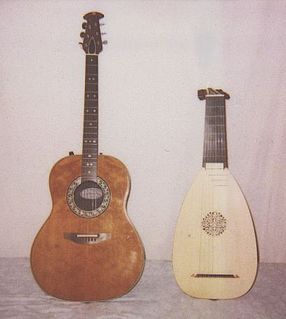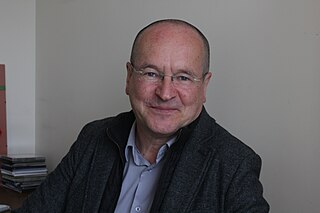Baltic psaltery is a family of related plucked box zithers, psalteries, historically found in the southeast vicinity of the Baltic Sea and played by the Baltic people, Baltic Finns, Volga Finns and northwestern Russians. [1]
Baltic psaltery is a family of related plucked box zithers, psalteries, historically found in the southeast vicinity of the Baltic Sea and played by the Baltic people, Baltic Finns, Volga Finns and northwestern Russians. [1]
Baltic psalteries include:
The internationally most known instrument of the family is Finnish kantele, so its name is sometimes used in English to also refer to other Baltic psalteries as well. Many of the Baltic psalteries hold a strong symbolic significance in their respective countries, including Finland, Latvia, Lithuania, Estonia and Russia, where playing instruction and instrument makers are available. [2]
According to Finnish linguist Eino Nieminen, the names kanklės, kantele, kannel, kāndla and kokles possibly come from the proto-Baltic form *kantlīs/*kantlēs, which originally meant 'the singing tree', [3] [4] ultimately deriving from the Proto-European root *qan- ('to sing, to sound'). However, Lithuanian ethnologist Romualdas Apanavičius believes they could be derived from the Proto-European root *gan(dh)-, meaning 'a vessel; a haft (of a sword)', suggesting that it may be related to the Russian word gusli. [5] [6]
Since 1990 Baltic Psaltery Symposia have taken place in Finland (1990; 1997; 2008), Lithuania (1994; 2017), Latvia (2000), Canada (2004) and Estonia (2013) every three or four years on a rotating basis. [7]

A kantele or kannel is a traditional Finnish and Karelian plucked string instrument (chordophone) belonging to the south east Baltic box zither family known as the Baltic psaltery along with Estonian kannel, Latvian kokles, Lithuanian kanklės and Russian gusli.
Baltic may refer to:

Dievturība is a neopagan movement which claims to be a modern revival of the ethnic religion of the Latvians before Christianization in the 13th century. Adherents call themselves Dievturi, literally "Dievs' keepers", "people who live in harmony with Dievs". The movement is mainly based on Latvian folklore, old folk songs (dainas) and Latvian mythology.

The Baltic states, also known as the Baltic countries, Baltic republics, or simply the Baltics, is a geopolitical term, typically used to group the three sovereign states on the eastern coast of the Baltic Sea: Estonia, Latvia, and Lithuania. The term is not used in the context of cultural areas, national identity, or language, because while the majority of people in Latvia and Lithuania are Baltic people, the majority in Estonia are Finnic. All three states are part of the European Union. The three governments engage in intergovernmental and parliamentary cooperation. There is frequent cooperation in foreign and security policy, defence, energy, and transportation.
Nordic folk music includes a number of traditions in Northern European, especially Scandinavian, countries. The Nordic countries are Iceland, Norway, Sweden, Denmark and Finland.
Traditional Latvian music is often set to traditional poetry called dainas, featuring pre-Christian themes and legends, drone vocal styles and Baltic psaltery.

Gusli is the oldest East Slavic multi-string plucked instrument, belonging to the zither family, due to its strings being parallel to its resonance board. Its roots lie in Veliky Novgorod in Novgorodian Rus'. It may have a connection to the Byzantine form of the Greek kythare, which in turn derived from the ancient lyre, or might have been imported from Western and Central Europe during the Middle Ages, when the zither had immense popularity. It has its relatives in Europe and throughout the world: kantele in Finland, kannel in Estonia, kanklės in Lithuania, kokles in Latvia, Zither in Germany, citera in the Czech Republic, psalterium in France and so on... Furthermore, the kanun has been found in Arabic countries, and the autoharp, in the United States. It is also related to such ancient instruments as Chinese gu zheng, which has a thousand-year history, and its Japanese relative koto. A stringed musical instrument called guslim is listed as one of the Me in ancient Sumer.

The kanklės is a Lithuanian plucked string instrument (chordophone) belonging to the Baltic box zither family known as the Baltic psaltery, along with the Latvian kokles, Estonian kannel, Finnish kantele, and Russian gusli.

Kokle or historically kokles (kūkles) is a Latvian plucked string instrument (chordophone) belonging to the Baltic box zither family known as the Baltic psaltery along with Lithuanian kanklės, Estonian kannel, Finnish kantele, and Russian gusli. The first possible kokles related archaeological findings in the territory of modern Latvia are from the 13th century, while the first reliable written information about kokles playing comes from the beginning of the 17th century. The first known kokles tune was notated in 1891, but the first kokles recordings into gramophone records and movies were made in 1930s. Both kokles and kokles playing are included in the Latvian Culture Canon.

Kannel is an Estonian plucked string instrument (chordophone) belonging to the Baltic box zither family known as the Baltic psaltery along with Finnish kantele, Latvian kokles, Lithuanian kanklės, and Russian gusli. The Estonian kannel has a variety of traditional tunings. In Estonia, studying the kannel has made a resurgence after some years of decline.

Plucked string instruments are a subcategory of string instruments that are played by plucking the strings. Plucking is a way of pulling and releasing the string in such a way as to give it an impulse that causes the string to vibrate. Plucking can be done with either a finger or a plectrum.

The Baltic Finnic peoples, Baltic Sea Finns, Baltic Finns, sometimes also Western Finns, often simply referred to as the Finnic peoples, are Finno-Ugric peoples inhabiting the Baltic Sea region in Northern and Eastern Europe who speak Finnic languages, including the Finns proper, Estonians, Karelians, Veps, Izhorians, Votes, and Livonians, as well as their descendants worldwide. In some cases the Kvens, Ingrians, Tornedalians and speakers of Meänkieli are also included separately rather than as a part of Finns proper.
The box zither is a class of stringed instrument in the form of a trapezoid-shaped or rectangular, hollow box. The strings of the box zither are either struck with light hammers or plucked. Among the most popular plucked box zithers are the Arab qānūn and its various derivatives, including the harpsichord.

The background of the occupation of the Baltic states covers the period before the first Soviet occupation on 14 June 1940, stretching from independence in 1918 to the Soviet ultimatums in 1939–1940. The Baltic states gained their independence during and after the Russian revolutions of 1917; Lenin's government allowed them to secede. They managed to sign non-aggression treaties in the 1920s and 1930s. Despite the treaties, the Baltic states were forcibly incorporated into the Soviet Union in 1940 in the aftermath of the German–Soviet pact of 1939.

The Soviet occupation of the Baltic states covers the period from the Soviet–Baltic mutual assistance pacts in 1939, to their invasion and annexation in 1940, to the mass deportations of 1941.

The Soviet Union occupied most of the territory of the Baltic states in its 1944 Baltic Offensive during World War II. The Red Army regained control over the three Baltic capitals and encircled retreating Wehrmacht and Latvian forces in the Courland Pocket where they held out until the final German surrender at the end of the war. The German forces were deported and the leaders of Latvian collaborating forces were executed as traitors. After the war, the Baltic territories were reorganized into constituent republics of the USSR until they declared independence in 1990 amid the collapse of the Soviet Union.
Olga Shishkina is a Russian born gusli and kantele artist currently residing in Helsinki, Finland. She is known for her virtuosity and innovation reflected in developing new techniques and expanding the repertoire of the instrument.

Valdis Muktupāvels is a Latvian ethnomusicologist, composer, musician, teacher and doctor of art criticism.
| Wikimedia Commons has media related to Baltic psaltery . |